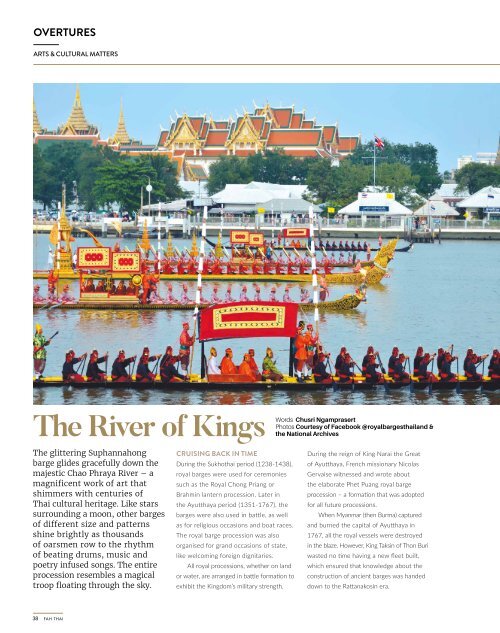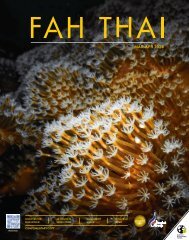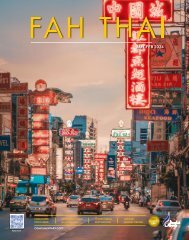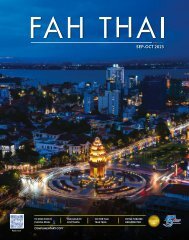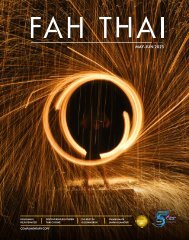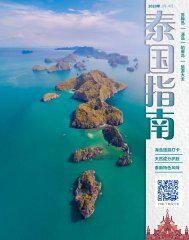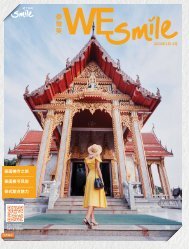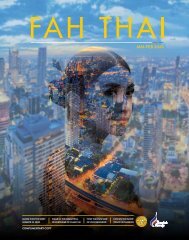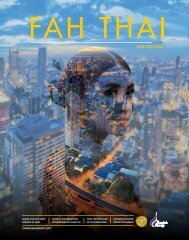You also want an ePaper? Increase the reach of your titles
YUMPU automatically turns print PDFs into web optimized ePapers that Google loves.
OVERTURES<br />
ARTS & CULTURAL MATTERS<br />
ROYAL BARGES IN RATTANAKOSIN<br />
The River of Kings<br />
The glittering Suphannahong<br />
barge glides gracefully down the<br />
majestic Chao Phraya River – a<br />
magnificent work of art that<br />
shimmers with centuries of<br />
<strong>Thai</strong> cultural heritage. Like stars<br />
surrounding a moon, other barges<br />
of different size and patterns<br />
shine brightly as thousands<br />
of oarsmen row to the rhythm<br />
of beating drums, music and<br />
poetry infused songs. The entire<br />
procession resembles a magical<br />
troop floating through the sky.<br />
CRUISING BACK IN TIME<br />
During the Sukhothai period (1238-1438),<br />
royal barges were used for ceremonies<br />
such as the Royal Chong Priang or<br />
Brahmin lantern procession. Later in<br />
the Ayutthaya period (1351-1767), the<br />
barges were also used in battle, as well<br />
as for religious occasions and boat races.<br />
The royal barge procession was also<br />
organised for grand occasions of state,<br />
like welcoming foreign dignitaries.<br />
All royal processions, whether on land<br />
or water, are arranged in battle formation to<br />
exhibit the Kingdom’s military strength.<br />
Words Chusri Ngamprasert<br />
Photos Courtesy of Facebook @royalbargesthailand &<br />
the National Archives<br />
During the reign of King Narai the Great<br />
of Ayutthaya, French missionary Nicolas<br />
Gervaise witnessed and wrote about<br />
the elaborate Phet Puang royal barge<br />
procession – a formation that was adopted<br />
for all future processions.<br />
When Myanmar (then Burma) captured<br />
and burned the capital of Ayutthaya in<br />
1767, all the royal vessels were destroyed<br />
in the blaze. However, King Taksin of Thon Buri<br />
wasted no time having a new fleet built,<br />
which ensured that knowledge about the<br />
construction of ancient barges was handed<br />
down to the Rattanakosin era.<br />
King Rama I of the Chakri Dynasty<br />
revived the tradition of royal barge<br />
processions for the kathin ceremony held<br />
at the end of Buddhist Lent, and built the<br />
Si Suphannahong, which was used as the<br />
primary royal barge for over a century.<br />
However, with the invention of<br />
motorised boats and no wars to fight,<br />
these magnificent ancient barges are<br />
nowadays used purely for ceremonial<br />
purposes, such as the Royal Coronation<br />
and the Royal Kathin procession.<br />
Built from teakwood, the royal barges<br />
gradually deteriorated over time, and<br />
the Si Suphannahong was replaced by<br />
the Suphannahong – constructed on the<br />
orders of King Rama V and completed<br />
during the reign of King Rama VI.<br />
During the reign of Rama V, the<br />
Prince of Nakhon Sawan reorganised the<br />
original extravagant fleet formation into the<br />
standard “major” and “minor” formations,<br />
which are still used today. The major<br />
formation is reserved for royal ceremonies<br />
and momentous occasions of state.<br />
Opposite & Bottom<br />
Right<br />
Royal Barges<br />
proceed down the<br />
Chao Phraya River<br />
as they rehearse for<br />
the Royal Kathin<br />
Ceremony, which<br />
will be held on<br />
<strong>Oct</strong>ober 24, <strong>2019</strong>.<br />
Top<br />
An image from the<br />
National Archives<br />
of the grand Royal<br />
Barge Procession<br />
held for the<br />
investiture of Siam’s<br />
first Crown Prince,<br />
Maha Vajirunhis<br />
- the eldest son<br />
of King Rama V<br />
and Queen Savang<br />
Vadhana.<br />
Centre<br />
The mythological<br />
creature Sukrip<br />
forms the figurehead<br />
of an escort vessel.<br />
When absolute monarchy ended in<br />
1932, the royal barges were placed under<br />
wraps and out of public view, where they<br />
would remain for more than two decades.<br />
Most of the vessels were kept near Thon Buri<br />
train station, where they were damaged<br />
by bombing in World War II.<br />
In 1959, King Bhumibol Adulyadej<br />
or Rama IX refloated the ancient and<br />
glittering tradition, reviving the Royal Barge<br />
Procession for the Royal Kathin Ceremony.<br />
Currently, four royal barges<br />
are in service: the 102-year-old<br />
Anekkachatpuchong, the 108-yearold<br />
Suphannahong, the 95-year-old<br />
Anantanakkharat and the 23-year-old<br />
Narai Song Suban HM Rama IX. The<br />
oldest, Suphannahong, was honoured<br />
with Maritime World Heritage status by<br />
the World Ship Trust in 1992.<br />
The escort vessels and cannonequipped<br />
barges, whose figureheads<br />
of mythical creatures represent official<br />
seals or noble ranks in ancient times,<br />
were built around a century ago.<br />
38<br />
39


